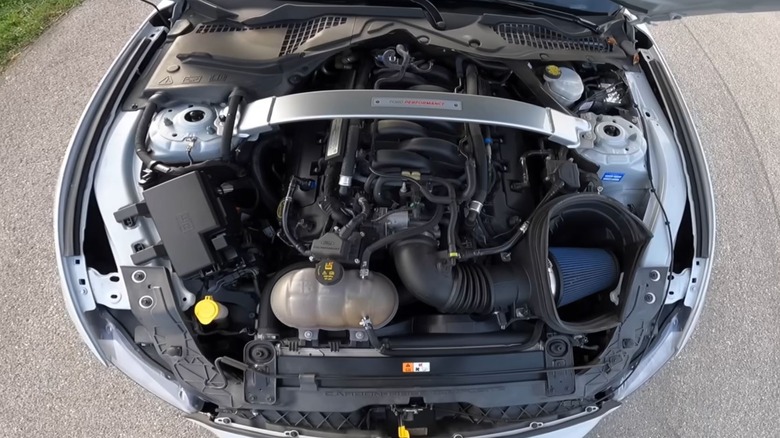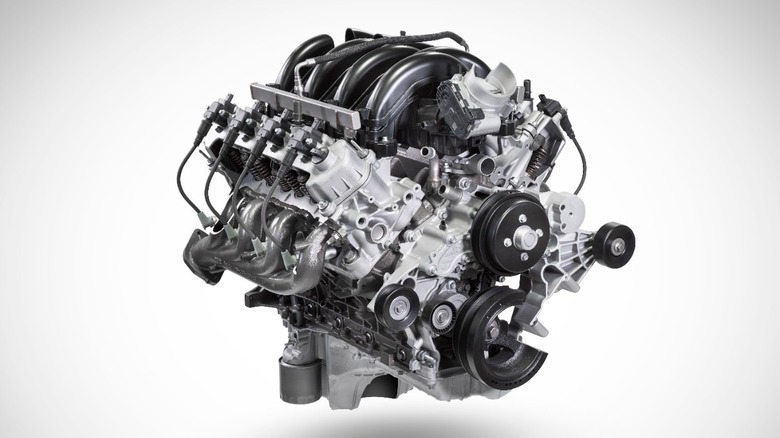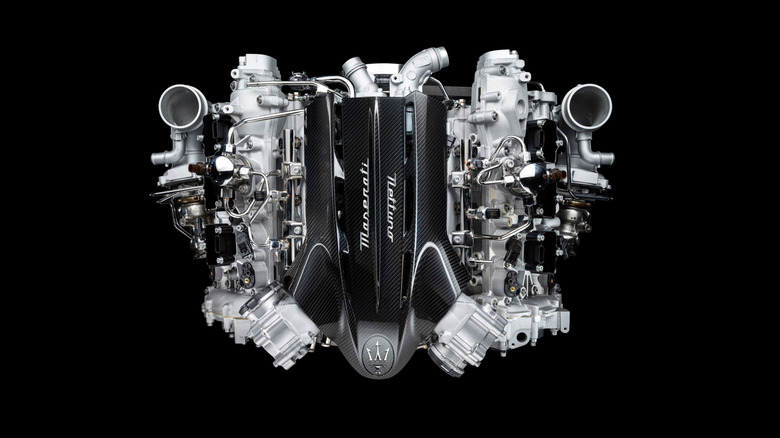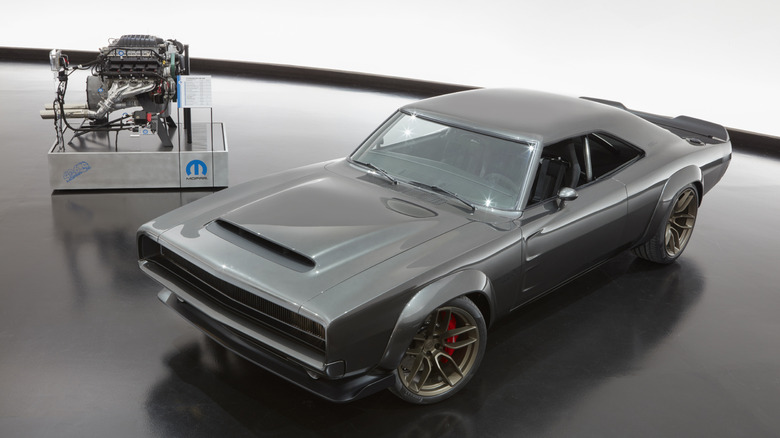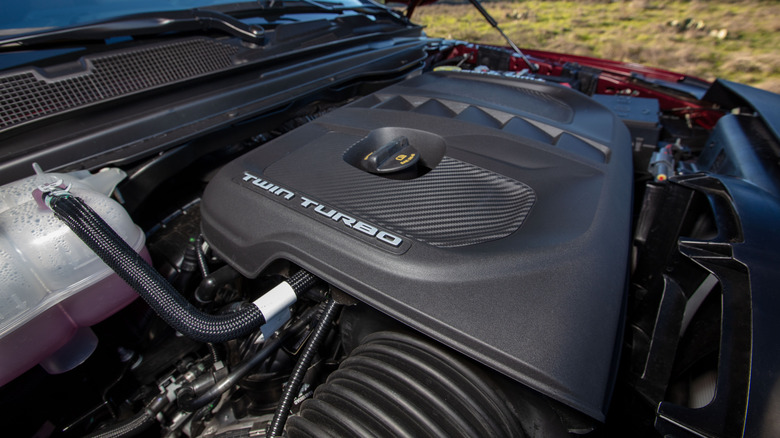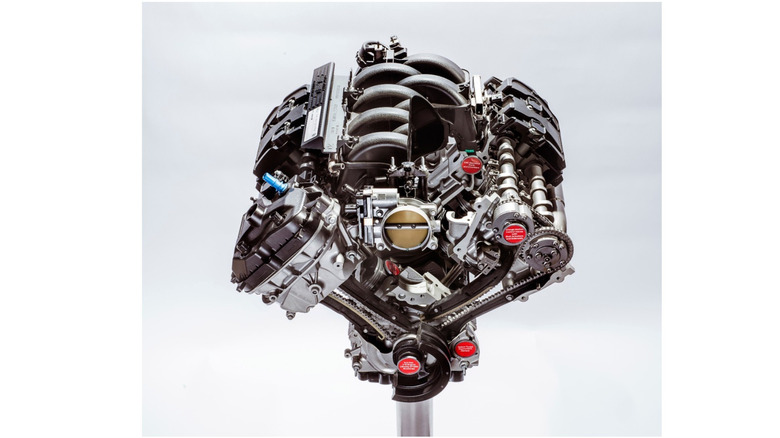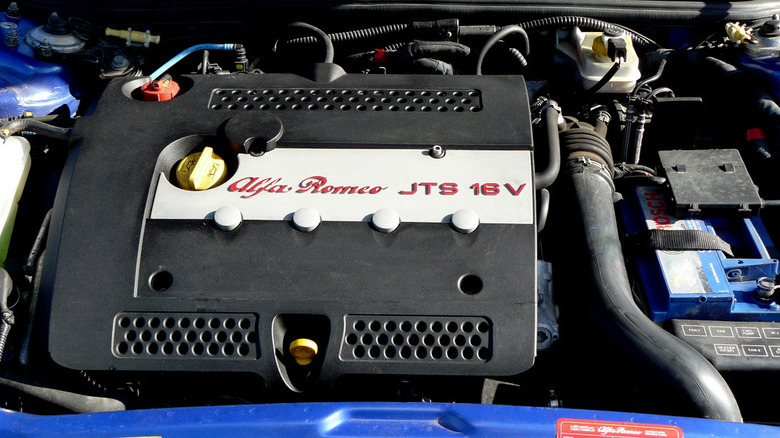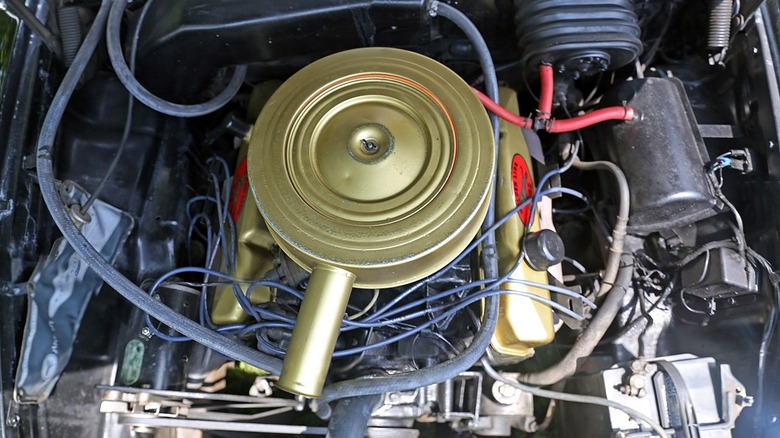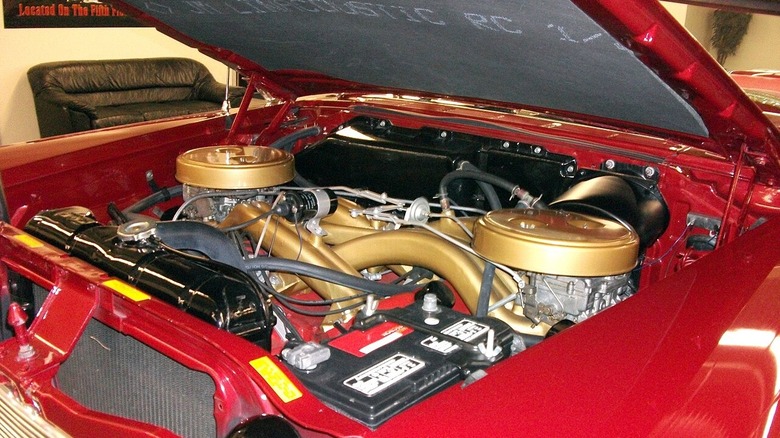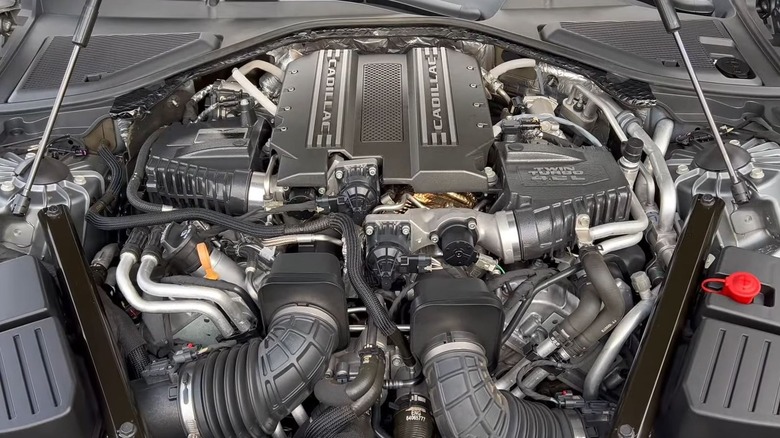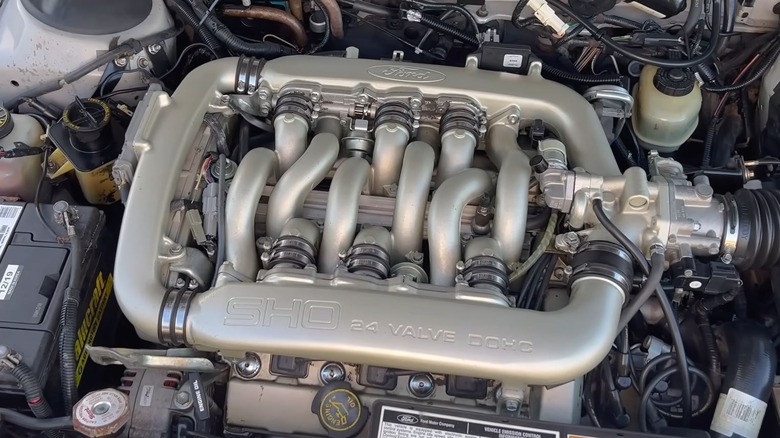The 10 Most Epic Engine Names Of All Time
Across the long history of the automobile, there have been loads of epic internal combustion engines with staggering output figures and stunning performance credentials. But not every automaker manages to come up with names for these noteworthy engines to matches their specs. Honda's VTEC, Mazda's Rotary, the BMW S54, and the Chevy Small Block are all car engines worth celebrating, but their names aren't exactly interesting — at least, not in my book.
For an engine name to be considered epic, I'd say it needs to appeal not only to the gearhead who already knows what it is, but to the average consumer who sees cars as point A to point B transportation appliances. If I tell my wife her new Nissan has the legendary RB26DETT engine, she will look at me like I have three heads. However, were I to note the Super Duty in the driveway is powered by Godzilla, she might raise an eyebrow or two. These 10 epic engines are the rare models with names that even your non-enthusiast friends and family would likely find interesting.
Ford 7.3-liter Godzilla V8
Godzilla is an epic name all by itself, conjuring images of a massive nuclear-breathing dinosaur beasty — or the Nissan Skyline. But in the car engine world, this internal codename is used by Ford to describe a V8 that could be considered a monstrous beast of its own. Debuting in 2019 for the then-new Super Duty line of trucks, the Godzilla is a naturally aspirated 7.3-liter V8 making 430 hp at 5,500 rpm and 475 lb-ft of torque at 4,000 rpm.
That those numbers were already best-in-class, but Ford's Godzilla was perhaps even more noteworthy for its pushrod configuration. That's because starting in 1996, Ford's gasoline V8s featured an overhead-cam design, including the 6.8-liter Triton V10, the torquey diesel alternative in the Blue Oval's lineup going back to 1997. By fitting Godzilla with a cam-in-block pushrod-activated valvetrain, Ford was able to engineer a relatively compact new V8 that was still an absolute monster.
Highlights include a fully skirted iron block, a forged steel crankshaft supported by cross-bolted main caps, and EcoBoost-derived pistons with oil cooling jets. The Godzilla also sports a composite manifold with intake ports designed by the same person responsible for Ford's 5.2-liter flat-plane crank V8 from the GT350. It all adds up to a remarkably high-tech old-school gas-powered V8. Though Ford never marketed the big 7.3-liter V8 under the Godzilla name, this internal codename is easily one of the most epic engine names of all time.
Maserati 3.0-liter Twin-Turbo Nettuno V6
Ferrari may take the spotlight for its incredible engines, but names like Colombo and Dino don't hold a candle to Nettuno. The Italian word for Neptune references Maserati's trident logo, itself inspired by the statue of said Roman god that stands tall in Bologna, Italy's Piazza Maggiore. Nearly 100 years after the Italian automaker's 1926 debut, it brought the Nettuno to life as a cutting-edge 3.0-liter twin-turbo V6. Revealed in 2020 to power the all-new MC20, it was Maserati's first 100% in-house designed powertrain in 20 years.
With 621 hp at 7,500 rpm and 538 lb-ft of torque between 3,000 and 5,500 rpm, the engine features an innovative prechamber combustion system with twin spark plugs lifted from Formula 1. Though not a new idea, the way Maserati blended it with a pair of turbos on a production engine with port and direct injection definitely is. At lower engine speeds, the Nettuno's combustion is initiated by the main spark plug within a given cylinder. As load increases, combustion kicks off in the separately sparked prechamber, and is released via small holes in the bottom to help spread the flame front more quickly in the main chamber.
Maserati designed the Nettuno to handle up to 29 psi of boost, which has helped it become one of the most powerful engines in production today. This also translates to a specific output of 207.6 hp/liter. That made the Nettuno more power-dense, at the time, than any engine from the likes of McLaren, Ferrari, Lamborghini, or Porsche.
Mopar 426 Supercharged Hellephant V8
Chrysler has leaned deeply into Hell-branded engines with the production Hellcat and aftermarket Hellcrate, but Hellephant is easily the most epic of its HEMI engine names. When the original 426 HEMI debuted back in the 1960s, it earned the Elephant nickname due to its massive power and size. So, when this modern Mopar mill debuted at the 2018 SEMA show with the "mammoth" output figures of 1,000 hp and 950 lb-ft of torque, it came with the brand name Hellephant. Very apropos.
Highlights include a 4.0-inch stroke and 4.125-inch bore, an aluminum block pulled from the Challenger Drag Pak vehicles, extensive webbing and gussetting for weight savings, and a special high-lift cam with custom forged pistons. Strapped with 3.0-liter IHI twin-screw supercharger spooling up to 15 psi of boost, the Hellephant lived up to its name. For the unveiling, Mopar mounted the 7.0-liter brute in a customized 1968 Dodge "Super Charger" concept, blending old school cool with modern touches like the T-6060 6-speed manual and Devil's rims from the Challenger Hellcat.
The wonderfully old-school Hellephant marked the first time an OEM automaker offered up a crate engine with 1,000 hp, and the public responded. Selling out in just two days, the Mopar folks got to work on additional production runs and new variants to satisfy demand. Personally, I want one just for the excellent Hellephant emblems that go with it, but the power output is pretty nice too.
Chrysler 3.0-liter Hurricane High Output Straight-Six Turbo
Willys may have cornered the market for high-wind engine names like the Hurricane, Super Hurricane, and Tornado back in the 1950s, but this modern Chrysler variant is arguably more impressive — if nameplate character count is an important metric. On the Ram 1500 Tungsten, the 3.0-liter Hurricane High Output Straight-Six Turbo is distilled to a polished hood badge reading simply 1500 SST HO, which definitely piques the enthusiast interest. However, this modern Hurricane is even cooler when you dig into the details.
Part of Chrysler's push away from V8s, the twin-turbocharged 3.0-liter inline-six Hurricane in High Output (HO) guise is said to offer better fuel economy, reduced emissions, and more power than typical naturally aspirated V8s and boosted six-pots in the light-duty truck segment. Impressive, considering it makes 540 hp and 521 lb-ft of torque. To get there, the HO features a deep-skirt cast aluminum block with a forged and twisted steel crankshaft. The block is deck-plate honed and pairs with an aluminum alloy head running forged aluminum pistons with a plasma transfer wire arc (PTWA) coating on the bores. Chrysler says it's the strongest Ram engine in history.
The Hurricane also boasts ion-sense coils, an interesting technology that aims to read the color of the spark plugs in real time for gauging combustion quality. Other notable features include the dual low-inertia turbos, each feeding three cylinders, and a water-to-air intercooler on the intake side, ensuring a short path for the intake charge. There's a reason it won a Ward's 10 Best Engine Award in 2024.
Ford 5.2-liter Voodoo V8
Ferrari may comes to mind first when discussing flat-plane crank V8s, but Ford deserves a nod for inventing the best name for this exotic engine configuration. Codenamed Voodoo, this naturally aspirated 5.2-liter V8 was developed exclusively for the Shelby GT350 and GT350R Mustangs in 2015. The most powerful and power-dense naturally aspirated V8 in Ford history when it debuted, the Voodoo cooked up 526 hp at 7,500 rpm and 429 lb-ft of torque at 4,750 rpm with a specific output of 102 hp/liter. The 8,250-rpm redline was also a high-water rev mark for the Blue Oval.
If the name Voodoo isn't enough to get you fired up about this spectacular lump of automotive engineering, the sound surely will. Ford described it as a "uniquely exotic, delicious engine note." Car and Driver simply called it "hellacious." It's all a result of how the Voodoo connecting rods are affixed to its crankshaft. Rather than the 90-degree intervals typical of cross-plane crank V8s, the Voodoo has its con rods aligned at 180-degree intervals. Viewed along the crankshaft axis, it appears to be a flat line of counterweights.
The fact that Ford spent what was surely a princely sum developing such an unusual engine for a single vehicle is amazing. But so are the juicy 5.2-liter Voodoo details — a unique aluminum block with PTWA coated liners, a "gun drilled" forged steel crankshaft to save weight, hollow-stem intake and sodium-filled exhaust valves, plus a single 87 millimeter throttle body. That latter component was the largest ever fitted to a Ford engine and is just one more reason the Voodoo is so epic.
Alfa Romeo Jet Thrust Stoichiometric
Jet Thrust Stoichiometric is not a phrase I would instantly identify as belonging to a car engine, but it sure is epic and does indeed come from the automotive world. JTS for short, this mouthful of an engine name was devised by Italian automaker Alfa Romeo in the early 2000s. Featuring the same 2.0-liter displacement as its prior Twin Spark inline-four, the 2.0 JTS found a home in vehicles like the 156 and GT sports coupe.
For those unfamiliar, stoichiometric refers to the stoichiometric ratio, the exact blend of air and fuel at which complete combustion takes place. In the Alfa, that point was the conventional air-fuel ratio of 14.7:1, which didn't kick in on the 2.0 JTS until engine speed moved past about 1,500 rpm. Below that level, it operated as a lean burn system, all of which was an innovative take on direct injection (DI) at the time. It was the first Alfa Romeo gas engine where the fuel injectors operated directly within the combustion chamber and was the most powerful DI gas-powered engine in production at the time.
Making 165 hp at 6,400 rpm and 152 lb-ft of torque at 3,250 rpm, the 2.0 JTS was impressively potent for its size. It could run a stratified charge lean burn system at low speed for efficiency before running the "stoich" ratio above that for maximum performance. The Jet Thrust part of the JTS moniker seemingly had nothing to do with how this engine worked, but it certainly elevated the JTS into the realm of car engines with epic names.
Chrysler Golden Lion V8
There is no shortage of epic engine names featuring animals, but Golden Lion is easily one of the best. Only sold briefly with 1959 and 1960 Chryslers, the Golden Lion was a V8 in 383 or 413 cubic inch spec. From the RB engine family, this wedge-head V8 was advertised as the smoothest, quietest, most rugged V8 in Chrysler history. The Golden Lion was a 90-degree lateral overhead-valve design with a 4.14-inch bore and 3.75-inch stroke on the big 413 that ran a 10.1:0 compression ratio.
In the 1959 New Yorker model, the Golden Lion 413 featured a 4-barrel carburetor and was rated for 350 hp. These gloriously finned chrome cruisers could be ordered in a range of body styles from a 2- or 4-door hardtop to a convertible and station wagon. Lesser versions, like the Windsor, came with the 383 mill making 305 hp. Design cues included a leaping lion on the front fenders, a gold-finished air cleaner cover, and Golden Lion 413 graphics on the valve covers.
An instant hit with the performance crowd, the torquey Golden Lion 413 saw use by racers including the Pettys. It was also adopted by Chrysler for its 1959 300E, where a pair of four-barrel carbs, high-output camshaft, and heavy duty valve springs helped push power up to 380 hp at 5,000 rpm and 450 lb-ft of torque at 3,600 rpm.
Plymouth SonoRamic Commando V8
Chrysler went wild with the Commando engine brand during the muscle car heyday, with memorable variants like the big-block 440 Super Commando and Golden Commando, but I have to give the SonoRamic Commando the gold star for most epic name of all. It's also one of the most visually arresting engines ever put out by an automaker thanks to a pair of super-long intake runners snaking from the side-mounted carburetors across the bay and into the engine.
Sold in 1960 and 1961 Plymouths, these long manifold pipes gave the SonoRamic its name. 10 years before it went into production, engineers were working on an experimental Indy 500 engine. By fitting different lengths of pipe between the carbs and intake valves, they figured out how to ram a sonic-pressured air-fuel mixture into the intake valves.
Dubbing this system "atmospheric supercharging", the new SonoRamic Commando made considerably more torque than a conventional V8 between 20 and 80 mph. The 383 cubic inch mill was rated for 330 hp and 460 lb-ft of torque and was made, per the period marketing, "for someone who appreciates unusual power in a car and can handle it." I appreciate this sentiment as much as I like the bizarre name. Unfortunately, few cars were built with the expensive SonoRamic Commando V8, making them rather rare today.
Cadillac Blackwing V8 Twin Turbo High Output
Not to be confused with today's Cadillac CT4-V and CT5-V sedans in range-topping Blackwing trim, this engine is from 2019 and named Blackwing. Specifically, a 4.2-liter twin-turbo V8 in High Output spec reserved for the CT6-V. Cadillac also sold a standard version of the Blackwing that made "just" 500 hp and 574 lb-ft of torque, but the HO variant was considerably more potent with 550 hp at 5,000 rpm and 640 lb-ft of twist at 3,400 rpm.
Paired with a 10-speed automatic and all-wheel drive, the CT6-V was as awesome as its engine name suggested. Enthusiast catnip included Magnetic Ride Control, 20-inch wheels hiding 14.5-inch front Brembos, a mechanical limited-slip diff, a carbon fiber rear spoiler, rear-wheel steering, and an active exhaust system. These rare CT6-Vs — only 1,200 were built over a two-year production span — could sprint to 60 in 3.8 seconds. All courtesy of the relatively crazy Blackwing mounted up front.
A clean sheet design, it was Caddy's first twin-turbo V8 and first dual overhead cam (DOHC) V8 since the Northstar engine. Featuring a sand-cast aluminum block, dual 59 millimeter throttle bodies, direct injection, and a pair of twin-scroll snails huffing up 20 psi of boost, the short-lived Cadillac Blackwing V8 was fairly exotic. Driving that point home was its hand assembly and signed builder plaque in the engine room.
Ford Super High Output V6
Any engine with the words High Output attached is worth getting excited about, but Super High Output? Cue the drooling. This was Ford's name for the Yamaha-developed 3.0-liter V6 found under the hood of its first-gen Taurus in Super High Output (SHO) form. Bonus points in the epic engine naming contest for the internal codename Shogun.
Technically sharing a foundation with the regular 3.0-liter V6 fitted to the period Taurus, the special SHO engine was dramatically modified to generate 220 hp at 6,000 rpm and 200 lb-ft of torque at 4,800 rpm. Up top was a 24-valve DOHC layout with 35 millimeter intake and 30 millimeter exhaust valves. A complex intake manifold, that is automotive artwork of the highest order, featured a pair of connected plenum chambers and 12 intake runners. Each plenum feeds into three short and three long runners. At lower engine speeds, a butterfly throttle in the short runners remains closed and then opens up above 4,000 rpm to allow free breathing across the entire 12-runner system.
This fascinating design had Car and Driver proclaiming that "Above 5,000 rpm, the Shogun engine sings like an exotic Italian V12." Considering the SHO could technically spin up to 8,500 rpm, but was limited to 7,300 in order to avoid blasting the accessory drive system to pieces, this praise makes sense. And from personal experience, I can tell you, the sound of Ford's naturally aspirated Super High Output V6 at full whack is as epic as its name.
